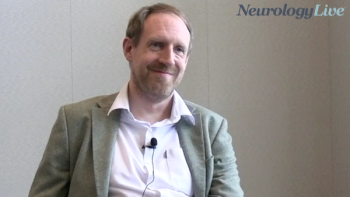
Overviewing Long-Term Efficacy of Zorevunersen From IEC 2025
Epilepsy expert Joseph Sullivan, MD, reviews 36-month results from the zorevunersen program, highlighting durable seizure reduction and sustained efficacy following dose optimization. [WATCH TIME: 4 minutes]
Episodes in this series

In this two-part NeurologyLive® Special Report, epilepsy experts Scott Perry, MD, and Joseph Sullivan, MD, provide clinical insights into zorevunersen, an investigational antisense oligonucleotide therapy in development for Dravet syndrome. Across both discussions, they explore the rationale behind targeting the SCN1A gene, review emerging efficacy and safety data, and highlight how gene-directed approaches may complement or go beyond current anti-seizure medications.
In this latest installment, Sullivan, director of the Pediatric Epilepsy Center at UCSF, discussed the 36-month data presented at IEC 2025, including long-term seizure reduction, Vineland-3 outcomes, and safety observations from the open-label extension. He also breaks down the design of the ongoing phase 3 EMPEROR trial and reflects on how zorevunersen continues to demonstrate additive benefit, even in patients already receiving highly effective therapies.
In this episode, Sullivan reviewed the long-term data from the phase 1/2 open-label extension studies presented at the recently concluded International Epilepsy Congress (IEC), held August 30-September 3 in Lisbon, Portugal. In the discussion, the epilepsy doctor provided greater background on the durability of the response observed in the study, even as participants stepped down from 70 mg to 45 mg doses. Overall, he stressed that the analysis reinforced sustained efficacy over time, alongside a favorable safety record and pharmacokinetic rationale for long-interval dosing.
Transcript was edited for clarity.
Joseph Sullivan, MD: This was really exciting data to present because this trial has been ongoing for quite some time. It’s important to remember that this was a phase 1/2a study, so there was no sham or placebo control—it was designed primarily to evaluate safety and dosing, since this was the first time zorevunersen was given to humans.
When we look back at how the study progressed, the first patients were enrolled at a 10 mg dose. Once that was deemed safe, the dose increased to 20 mg, then 30 mg. Eventually, multiple-dose arms were opened where patients could receive three doses, one month apart, of either 30 or 45 mg. That entire process unfolded gradually over time as the study evolved.
At the end of the initial phase 1/2a trials, which lasted about 12 months, patients were eligible to roll over into an open-label extension, where they continued receiving the doses determined to be safe at that time. I provide all this background because it helps explain the 36-month data: the patients included in this analysis went through that entire dose-escalation pathway. They started at the lower doses and then had the opportunity to receive higher doses over time.
The highest dose tested was 70 mg. Based on pharmacokinetic modeling, however, the plan was never to continue 70 mg long term in the open-label phase. The idea was to use the higher dose to reach adequate CNS exposure, and then maintain that effect using a lower 45 mg dose given every four months.
That’s essentially the key finding we reported. There are two cohorts presented: one that received doses below 70 mg, followed over 36 months, and another that received 70 mg and then rolled into the open-label extension. In the lower-dose group, we saw a gradual reduction in seizures over time, which makes physiologic sense. Because the drug has a long half-life, it accumulates in the CNS, leading to a potential additive effect with continued dosing.
Even more exciting was what we saw in the 70 mg cohort. One concern was whether patients would lose benefit once they transitioned down to 45 mg for maintenance dosing. Fortunately, that wasn’t the case. Patients who received 70 mg and then rolled into 45 mg maintenance continued to show a strong and sustained reduction in seizures, out to 20 months and beyond.
Overall, these results show a consistent and durable effect, with patients maintaining roughly a 75% reduction in seizures. Equally encouraging is the absence of major safety concerns, which we’ll discuss more in detail later. These data not only demonstrate the potential for long-term efficacy but also helped inform the dosing and structure of the ongoing phase 3 EMPEROR trial that’s currently enrolling.
Newsletter
Keep your finger on the pulse of neurology—subscribe to NeurologyLive for expert interviews, new data, and breakthrough treatment updates.

































